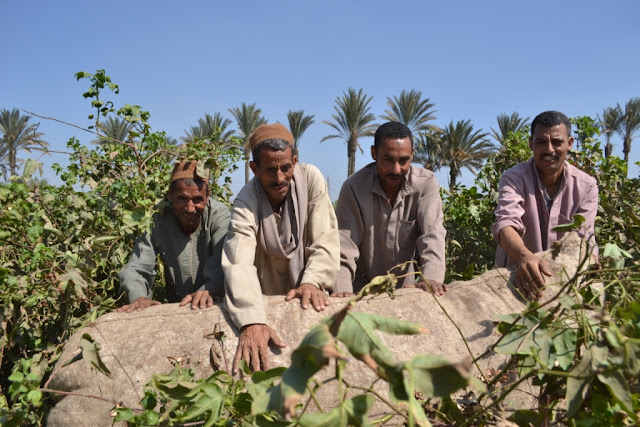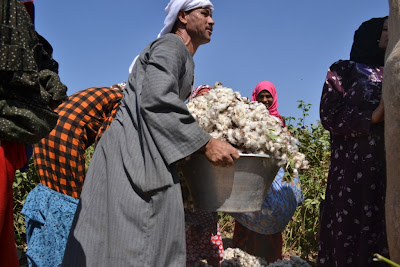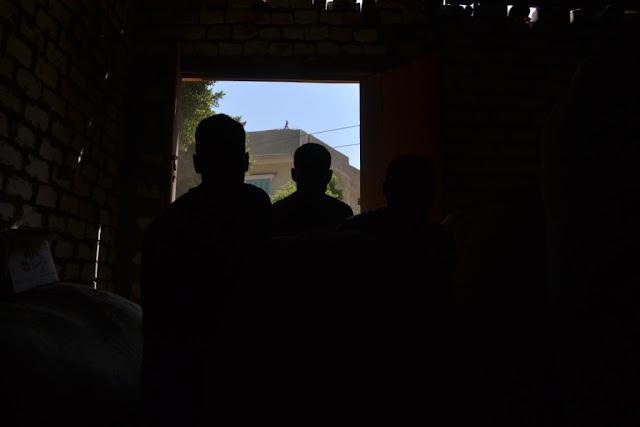I swear, this Koshary is delicious.
I've recently become a huge fan of this little Koshary cart in Dokki square. I wish I had discovered it forty years ago when it first started (and I was not yet born).
Koshary Ahmed al-Sunni (كشري احمد السني) serves Cairo's masses with delicious, complex, homemade koshary. So far I've eaten from there at least a dozen times, and every time I was 101% satisfied.
I think the best part about this koshary is the variety of the ingredients he uses. Koshary is always composed of rice, noodles, spaghetti, lentils, tomato sauce, and fried onions (You can then add some spicy sauce and garlic sauce if you want too) but usually each ingredient is limited to one type and rather insipid. Here, he uses a variety of noodles, rice, (brown, white, vermicelli) which gives each spoon-full a nice flavor.
The beauty here lies in simplicity: there are two sizes (L.E. 3.5 and L.E. 5) both of which are very filling. Make sure to tell him how much garlic, spicy sauce, and onions you want.
The only downside to this place (which can be seen as an advantage too) is that you either have to eat your bowl standing up (next to the cart), OR at a nearby ahua (there are three coffeshops, all of which you can leave your empty bowls at) OR at home (take away, teeka). I prefer the ahua-option so that I can accompany my koshary with a tea and some people-watching (or them staring at me).
Hours:
He's not usually there on Fridays. Sometimes he takes Saturday off too. During the week he's there from around 11am to 7pm. When he runs out of food, he goes home. Oh, the joys of being your own boss... :-)
As always with almost anywhere in Cairo: Buyer Beware. But for this koshary, I'm pretty sure that his 40-year old reputation is a good guarantee that you'll be safe (just keep off the spicy شطة!). Oh, and Ahmed, the fine gentleman who works there is super honest: once he insisted on giving me 1.5 LE back from a week before when I forgot to take my change.
So, if you're ever in Dokki during the day and find yourself craving koshary, don't go anywhere else but here! By far, it's the best koshary you'll find and at the best price!
I've recently become a huge fan of this little Koshary cart in Dokki square. I wish I had discovered it forty years ago when it first started (and I was not yet born).
 |
| Ahmed al-Sunni Koshary. (I like how the flower is coming out of the customer's head on the left) |
Koshary Ahmed al-Sunni (كشري احمد السني) serves Cairo's masses with delicious, complex, homemade koshary. So far I've eaten from there at least a dozen times, and every time I was 101% satisfied.
 |
| Here I am, eating away at 'Amr's ahua (see below) |
I think the best part about this koshary is the variety of the ingredients he uses. Koshary is always composed of rice, noodles, spaghetti, lentils, tomato sauce, and fried onions (You can then add some spicy sauce and garlic sauce if you want too) but usually each ingredient is limited to one type and rather insipid. Here, he uses a variety of noodles, rice, (brown, white, vermicelli) which gives each spoon-full a nice flavor.
 |
| Delicious texture |
 |
| Vermicelli. Angel's hair. |
The beauty here lies in simplicity: there are two sizes (L.E. 3.5 and L.E. 5) both of which are very filling. Make sure to tell him how much garlic, spicy sauce, and onions you want.
The only downside to this place (which can be seen as an advantage too) is that you either have to eat your bowl standing up (next to the cart), OR at a nearby ahua (there are three coffeshops, all of which you can leave your empty bowls at) OR at home (take away, teeka). I prefer the ahua-option so that I can accompany my koshary with a tea and some people-watching (or them staring at me).
Hours:
He's not usually there on Fridays. Sometimes he takes Saturday off too. During the week he's there from around 11am to 7pm. When he runs out of food, he goes home. Oh, the joys of being your own boss... :-)
As always with almost anywhere in Cairo: Buyer Beware. But for this koshary, I'm pretty sure that his 40-year old reputation is a good guarantee that you'll be safe (just keep off the spicy شطة!). Oh, and Ahmed, the fine gentleman who works there is super honest: once he insisted on giving me 1.5 LE back from a week before when I forgot to take my change.
So, if you're ever in Dokki during the day and find yourself craving koshary, don't go anywhere else but here! By far, it's the best koshary you'll find and at the best price!
 |
| In front of Hassouna. If you're coming out from the Dokki Metro station, take the "juhaina street" exit |
 |
| He's located at Midan Dokki, right in front of Hassouna |
 |
| A better view of Midan Dokki, with the Dokki Bridge in the background |
 |
| Customers |
 |
| In the street that goes off to the right of the photo, there's a coffee shop I usually eat at. |
 |
| A view of Midan Dokki and the cart from the ahua I eat at. |
 |
| 'Aamr's ahua. Right next to the Dokki Sudanese restaurant (pictured left) |
 |
| Me, happy, eating. |





































































